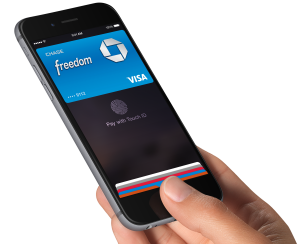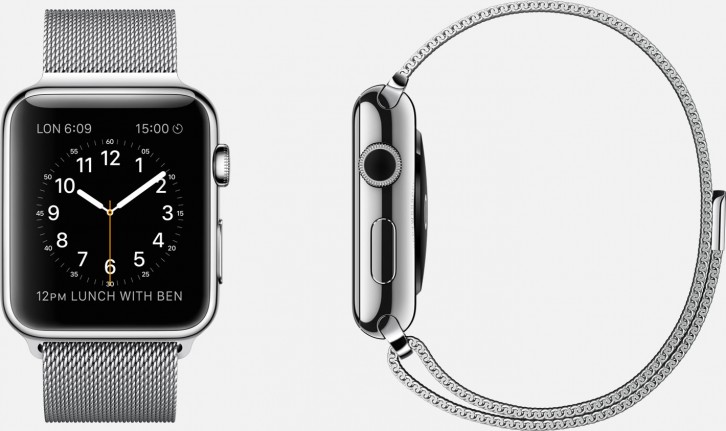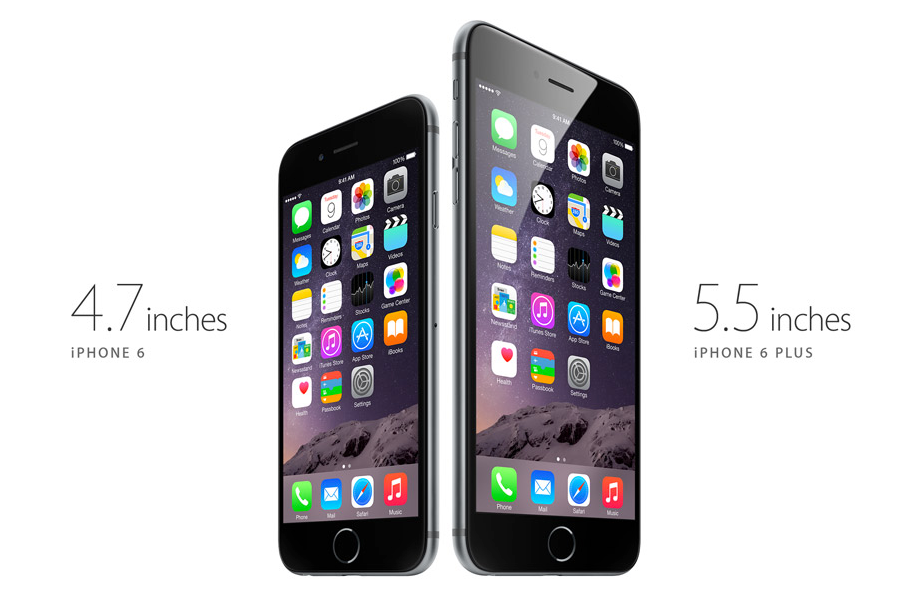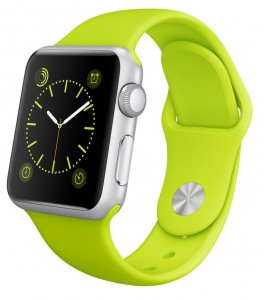As a self proclaimed techie, I always look forward to the fall as Apple usually has a slew of product announcements just in time for the holiday season. With the iPhone expected to get it’s bi-annual design refresh, and the widespread anticipation of a completely new product, I was really looking forward to the September 9 event, more so than in previous years. Usually, an Apple event begins with a “state of the union” update, with CEO Tim Cook outlining how successful Apple has been thus far with sales, market share, adoption rates, and customer satisfaction. This year, he simply said “things are great”, and moved swiftly to the new iPhone announcement. This could only mean one thing – that there was a lot to cover in the two hour period; my excitement shot up immediately.
The new iPhone 6 and iPhone 6 Plus feature a new curved edge/bullnose design, echoing the design cues that started with the iPod Touch two years ago, and followed with the iPad mini, and most recently, the iPad Air. The glass now curves at the edges, blending seamlessly into the metal unibody chassis. I personally like this design as I use left and right swipe gestures frequently, and the curved edge of the glass should make these gestures easier. It also makes the new iPhones more comfortable to hold, even more important now that they have significantly larger screens.
The iPhone 6 has a 4.7″ screen with a resolution of 1334×750; the iPhone 6 Plus has a 5.5″ screen with a resolution of 1920×1080. The new screens are called “Retina HD” displays because of these higher resolutions, as well as other advances that result in better colour reproduction, higher contrast, and wider viewing angles. The iPhone 6 Plus is able to display more information, and consequently gains a new landscape mode to take advantage of the larger screen real estate. The new iPhones also get the yearly processor speed bumps, this time with the next generation A8 and M8 chips, the latter of which also measures distance and elevation changes. As well, there are better antennas for cellular and wifi, boasting faster speeds and compatibility with more cell providers around the world; this is good news for travellers. One very important feature to note is wi-fi calling – this is extremely important for city dwellers where cell reception is not always great. I hope the Canadian carriers adopt this feature quickly.
The cameras have also been improved. While the megapixel count remains at 8 MP, the image processing of the A8 delivers less noise, faster face detection, and now slow motion video at 240 fps versus the 120 fps of the iPhone 5S. “Focus pixels” allow for phase detection autofocus – a feature found in high end cameras. This results in faster autofocus performance, and enables continuous focusing while shooting video. The iPhone 6 Plus adds one additional and extremely important feature for photographers, which is optical image stabilization. This allows sharp images to be shot in low light conditions, and smoother video. This might also explain the protruding camera, which is a bit of an eyesore on an otherwise elegant design.
 Finally, the new iPhones get an NFC (near field communications) chip. Coupled with Touch ID, this enables a new form of contactless payment they’ve dubbed Apple Pay. At thousands of existing payment terminals at stores, you’ll be able to pay wirelessly using your iPhone (and credit cards that you’ve stored inPassbook) by just placing your finger on the Touch ID sensor. Apple claims this new method of payment is secure (credit card information is stored in a secure enclave of the processor), and private – Apple does not know what you paid for, how much you paid, or what store. Furthermore, the cashier does not see your name or any credit card information. I vacationed in Barcelona in 2006, and it was the cashier at a candy shop that stole my credit card information to purchase airline tickets. Surely, Apple Pay will deter credit card fraud like this from happening. While Apply Pay is not one of those “wow”-inducing announcements, it is a quintessentially Apple solution to a longstanding problem that will fundamentally change something we do almost every day.
Finally, the new iPhones get an NFC (near field communications) chip. Coupled with Touch ID, this enables a new form of contactless payment they’ve dubbed Apple Pay. At thousands of existing payment terminals at stores, you’ll be able to pay wirelessly using your iPhone (and credit cards that you’ve stored inPassbook) by just placing your finger on the Touch ID sensor. Apple claims this new method of payment is secure (credit card information is stored in a secure enclave of the processor), and private – Apple does not know what you paid for, how much you paid, or what store. Furthermore, the cashier does not see your name or any credit card information. I vacationed in Barcelona in 2006, and it was the cashier at a candy shop that stole my credit card information to purchase airline tickets. Surely, Apple Pay will deter credit card fraud like this from happening. While Apply Pay is not one of those “wow”-inducing announcements, it is a quintessentially Apple solution to a longstanding problem that will fundamentally change something we do almost every day.
Cook called this the biggest advancement for the iPhone, but personally I think that’s a questionable claim. I still think the iPhone 4 was the biggest leap for the iPhone, introducing a classic, timeless design and also now-industry-standard technologies like super dense pixel screens and face to face communications. Its extremely capable camera (at the time) made smartphone photography mainstream and marked the decline of traditional point-and-shoots. With the iPhone 6 and 6 Plus it feels like Apple is playing catch-up with the larger screens, improved cameras, and the inclusion of NFC. Still, Apple continues to lead with its smartphone designs, and its seamless integration of hardware, software, and services.
Will I upgrade? Truthfully, I’m not sure yet. My iPhone 5S is still a very capable device, and with the impending iOS 8 update, it will gain new functionality and feel fresh again. NFC and Apple Pay would have been a compelling reason to upgrade, but alas this will only available in the U.S. initially. I’m also not a fan of the protruding camera, which is a blemish on a beautiful profile, as well as the bands across the back of the iPhone, likely there for antenna reception reasons. The wi-fi calling would also benefit me, but I’m not sure if my current cell provider will support this out of the box. Because I take a lot of pictures with my iPhone, the optical image stabilization is also a selling point, but sadly it’s only in the iPhone 6 Plus, which I find just too big. One other major deterrent is the price. The unlocked 16 Gb iPhone 4S sold for $649 in 2011, and now in 2014, the iPhone 6 will sell for $749, and the iPhone 6 Plus for $859. This rise in iPhone prices in recent years is no doubt in part because of the current Canadian dollar exchange rates; nevertheless it’s still an expensive purchase. On September 19, I will walk into an Apple Store to see these new iPhones, and perhaps fall in love with them, but right now the purchase is just a definite maybe.
While the iPhones are traditionally the focus of Apple’s September events, this year the spotlight shifted to an entirely new product – the Apple Watch. Apple has not announced a new product since the iPad in 2010, so this announcement was monumental, described by Cook as “the next chapter in Apple’s story”. Cook led off with “one more thing…”, to thunderous applause, paying homage to Steve Jobs‘ famous line during the iPhone announcement in 2007. A video narrated by Senior VP of Design, Jony Ive, then started playing, which formally introduced the Apple Watch.
So what is the Apple Watch? First of all, it is actually a watch. A lot of people these days have forgone wearing watches, including myself, instead opting to check the time on their smartphones. Those who continue to wear watches primarily wear them as a personal expression of style. With the Apple Watch, Apple is hoping to bridge the fashion and technology worlds.
Lets address the fashion aspect first. It looks like a beautiful and elegant timepiece. It comes in various finishes separated into three collections – Watch, Watch Sport, and Watch Edition. The Watch line uses a black or silver stainless steel body with a sapphire crystal display. The Watch Sport line is made from aluminium, with an Ion-X glass display. The Watch Edition line is more luxurious, using 18-karat yellow or rose gold, also with a sapphire crystal display. Each watch comes in two sizes – 38mm and 42mm. There are also six types of interchangeable bands, each with its own variants. It won’t be long before bands from third parties enter the foray. Coupled with the customizable watch faces you can choose from, there are quite literally infinite combinations to suit your personal style.
As for the technology aspect, the Apple Watch introduces a few new interesting advances. First is the digital crown – the same rotary dial found on classic watches, but adapted for scrolling or zooming, because multi-touch navigation is just impractical for a small display. The display itself is a Retina OLED screen, which uses ‘Force Touch’; it can distinguish a tap from a push, adding a new dimension of touch interaction. The Taptic engine produces haptic feedback – the Apple Watch will mimic a “tap” sensation your wrist. Along with these new technologies, there are also existing technologies integrated into the Apple Watch. There’s a heart rate monitor and accelerometer that combined with iPhone’s existing sensors measure physical activity. NFC is built in, which enables Apple Pay. Charging uses MagSafe – the same inductive charging used by MacBooks. The Apple Watch is definitely a technological marvel in such a diminutive size.
All of this hardware is great, but what about the software? Well, there’s a whole new OS and app eco-system being introduced with the Apple Watch. Unfortunately, for the Apple stock apps, nothing that was shown was truly exciting. When the iPhone was introduced, Jobs was masterful in demonstrating how extraordinarily useful the iPhone can be in one’s daily life, beyond just making phone calls. For the watch, Apple really needed to do the same – focus on how the watch is useful beyond just making a fashion statement and telling time. They talked briefly about the fitness, but it wasn’t anything we haven’t seen before in other fitness wearables like the Nike+ FuelBand. They showed notifications, but we’ve seen this done in existing wearables like the Pebble and the Samsung Galaxy Gear line. Apple really needed to go beyond what we’ve already seen from others, and show how its watch does the same things, and better.
Only the demos involving the Taptic engine were exciting. GPS navigation using haptic feedback is something that I would find personally useful, especially as a city cyclist. The tap and picto-messaging were cool, though I don’t know how many people will actually use this. This can become a very personal form of messaging; on the flip side, I can see this becoming as annoying as someone constantly tapping you for attention. I think there were missed opportunities in showcasing Siri; asking Siri for the weather, or directions, or to create reminders would be something I’d like to do without taking out my iPhone. Demonstrating remote control functionality should have also been more prominent. I was hoping to see tight integration with HomeKit for example; controlling smart home devices like lights, garage doors, and locks from my wrist via Siri, or some on-screen controls, would be incredibly useful. I was even hoping Apple would do something clever with HealthKit and HomeKit, like monitoring my sleep patterns, and slowly turning on the lights to wake me up at the optimal time in my sleep cycle. How about changing the channels on the TV, or fast-fowarding the currently playing movie on my Apple TV? Sadly, none of these were shown. Theoretically the Apple Watch is capable of all of these things; every day tasks that should be made easier by the Apple Watch. Only when some of the third party apps were mentioned did we see glimpses of its potential.
Major questions still linger about the Apple Watch. For me, the most important question is exactly how long will the battery last. Will I have to charge it daily? A battery life of a few days would be ideal; any shorter and it might become yet another device that I forget to charge. What functionality is available when iPhone is not nearby; can I go for a run without my iPhone? I would hope so, but we don’t know. Will there be Handoff functionality, similar to what’s possible with iOS 8 and OS X Yosemite? For example, when I’m reading an e-mail on an Apple Watch, will I be able to read the same e-mail readily on my iPhone? And what will it cost? Only the starting price of $349 USD was given, but what will it really cost after you’ve chosen the size, finish, and band that you want? Will it even be available in Canada at launch? All of these questions will hopefully be answered in early 2015, when the Apple Watch becomes available. For now, here’s hoping that Apple’s entry into the wearable space is as disruptive as its last two product introductions.


